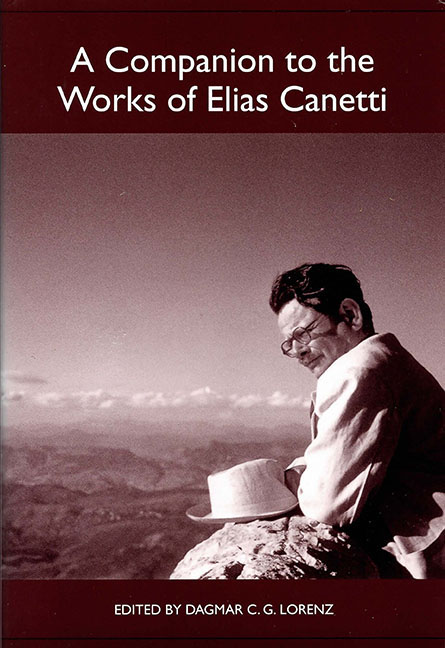Book contents
- Frontmatter
- Dedication
- Contents
- Canetti's Principal Works
- Abbreviations of Works Frequently Cited
- Introduction
- Canetti's Global Significance
- Writing and Language
- The Works: Themes and Genres
- Philosophy and Social Thought
- Historical Contexts
- Canetti, Roustchouk, and Bulgaria: The Impact of Origin on Canetti's Work
- Elias Canetti's Response to the Shoah: Masse und Macht
- Works Cited
- Notes on the Contributors
- Index
Elias Canetti's Response to the Shoah: Masse und Macht
from Historical Contexts
Published online by Cambridge University Press: 28 April 2017
- Frontmatter
- Dedication
- Contents
- Canetti's Principal Works
- Abbreviations of Works Frequently Cited
- Introduction
- Canetti's Global Significance
- Writing and Language
- The Works: Themes and Genres
- Philosophy and Social Thought
- Historical Contexts
- Canetti, Roustchouk, and Bulgaria: The Impact of Origin on Canetti's Work
- Elias Canetti's Response to the Shoah: Masse und Macht
- Works Cited
- Notes on the Contributors
- Index
Summary
The word Holocaust or Shoah is conspicuous in Elias Canetti's work by its absence. Why then discuss this topic in a companion volume dedicated to his oeuvre? It should be noted that, before the Eichmann trial in 1961, neither term was used to describe the Nazi genocide. Both denotations are in fact problematic. As this essay will examine, Canetti makes it clear that his analysis of both crowds and power goes hand in hand with an examination of the ways in which Nazism gained popular support within Germany and Austria.
This essay focuses on Canetti's work that grew out of such examination of Nazism's roots. In this respect Canetti described his scholarly investigation always with a view to political and social issues. He self-consciously analyzed both Masse and Macht within this specific historical context. But why does he not specifically mention Nazi concentration camps? This avoidance in fact points to one of Canetti's intellectual goals and literary strategies. As will be discussed here, Canetti depicts humanity's constitution and history in terms of genocide. Our bodies, our language, our food habits, our everyday behavior, in short, everything that has to do with us emerges as an integral part of a huge, all-encompassing killing machine, called “society” or “civilization.”
Readers might still question whether this brutal depiction of the human refers to Nazism in general and to the Shoah, in particular. There have, after all, been many writers and thinkers who had a decidedly unsavory view of humanity before they could have heard anything about what the Nazis were going to perpetrate. Canetti's response to the Shoah, by contrast, does not consist in representing a bleak worldview. His way of writing must not be confused with his anthropological and philosophical convictions. He depicts humanity qua violence, death, and survival, so as to shock his readers. In order to make this shock more efficient or, in other words, more real, Canetti employs literary devices by means of which he presents his scholarship in the light of “objective” reality.
We can thus address the hybrid position of Masse und Macht between literature and the social sciences: the author employs literary strategies that enhance the scientific truth claims of what he is depicting. Crucially, scientific truth here differs strikingly from positivist definitions of the same term. According to Canetti, that which is true has the capability to change the reader's life.
- Type
- Chapter
- Information
- A Companion to the Works of Elias Canetti , pp. 289 - 312Publisher: Boydell & BrewerPrint publication year: 2004

